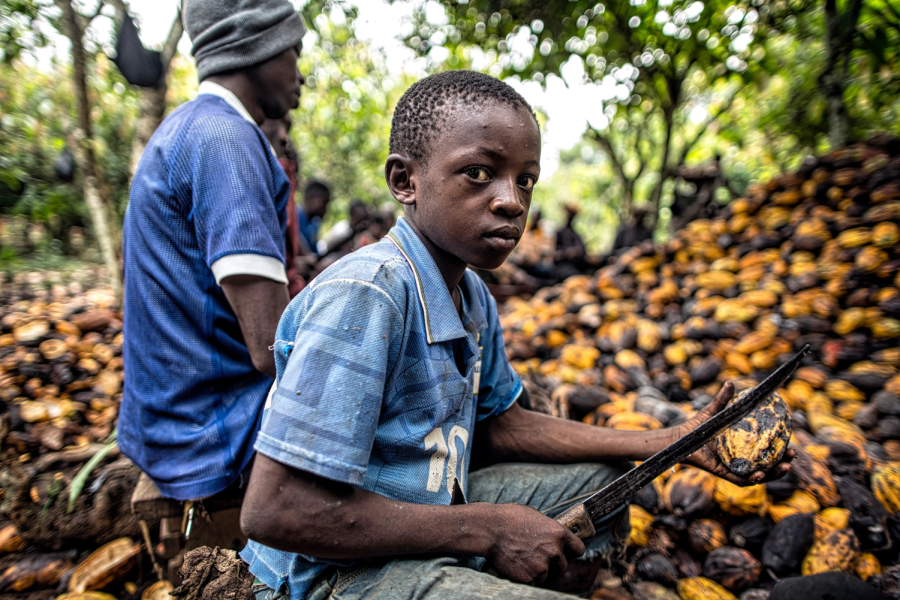Does Your Chocolate Come from Child Labor?
September 22, 2022
A steady stream of buses carries children from Burkina Faso to Côte d’Ivoire. The passengers, often 14 and 15 but some as young as ten, have been promised different things to take the long trip. Some were offered money; some came with the promise of education, and some were tempted by bikes. However, none of these promises will be fulfilled. These children will be put to work on cocoa farms and will not return to their homes.
Côte d’Ivoire is an essential source of the world’s supply of cocoa. 45% of the world’s supply comes from Côte d’Ivoire, one of a few west African countries that produce 70% of the world’s cocoa. Many families work on farms, and the average household makes only $1,900 annually. It’s well below the international poverty line. They can’t afford to send their children to school, so many begin working for their families from an early age. They carry loads, use machetes to clear land, and spray pesticides. This is not a new phenomenon. The awareness of child labor in the cocoa industry goes back to 2001. The companies Nestlé, Hershey, and Mars signed a pledge to eradicate “the worst forms of child labor” in their suppliers by 2005. However, many of the M&M’s and KitKat’s we enjoy begin with children’s work.
The goal to eliminate child labor by 2005 was never realistic, but efforts are still prolonged. Nestlé, one company involved in the promise, only began acting in 2020, 15 years after the original goal. They started a pilot program where they offered some families money and birth certificates to send their children to school. The application for the said program only began this year. In Côte d’Ivoire, 80% of their cocoa is considered certified, meaning it has been ethically produced. However, the certification for cocoa is far from foolproof. Fairtrade and Rainforest Alliance, the third-party inspectors, visit less than 10% of the cocoa farms that supply these companies. Antonie Fountain, a managing director of the VOICE Network advocating for sustainable cocoa and an end to forced labor in the industry, had a pessimistic outlook on why solutions have stalled for so many years.
“We haven’t eradicated child labor because no one has been forced to,” Fountain claims. “What has been the consequence […] for not meeting the goals? How many fines did they face? How many prison sentences? None. There has been zero consequence.” This statement is true in the face of previous cases against chocolate producers.
In a supreme court case against Nestlé and Cargill, the corporations were found not guilty on June 17, 2021. Six individuals from Mali who were trafficked as children accused the company of aiding and abetting child trafficking and child labor. In the case syllabus, “respondents here improperly seek extraterritorial application of the ATS.” The ATS or Alien Tort Statute allows federal courts to hear lawsuits filed by non-US citizens for torts committed in violation of international law.
Because Nestlé was not providing to their suppliers within the US, they were declared not guilty by the Supreme Court.
Some suggest putting regulations on companies supplied by Côte d’Ivoire, which was made unlikely by the Harkin-Engel Protocol in 2001. A measure to label which products were involved with child labor passed in the House of Representatives, but the industry insisted that government regulation was not needed, and they were already working on eliminating child labor. Susan Smith, a spokesperson for the Chocolate Manufacturers Association, stated, “We don’t need legislation to deal with the problem. We are already acting.” In the end, chocolate companies were told to develop and implement standards of public certification to show that child labor was not used. In return, federal regulators were not allowed to police the chocolate supply. As mentioned previously, labels by Fairtrade would not be enough due to their lack of inspection policies.
Farmers using child labor usually usher children off their farms when inspectors come, or they get the children to lie about their ages. Although they are partly responsible for perpetuating the cycle, many have few other choices because of rampant poverty. Cocoa prices are meager and make life difficult. Sometimes, parents sell their children off because of how hard things are. “I admit that it is a kind of slavery,” said one farmer overseeing teenage workers. “They are still kids, and they have the right to be educated today. But they bring them here to work, and it’s the boss who takes the money.”
The most significant debate has been around where company responsibility ends. Some claim that Nestlé should be held responsible for perpetuating child slavery. In contrast, others argue that the governing bodies of Burkina Faso, Mali, and Côte d’Ivoire should do their part in cracking down on child labor. However, both countries are short on money and resources. To those in Mali and Burkina Faso, Côte d’Ivoire is a land of opportunity. There may be a small amount of money in Côte d’Ivoire, just 85 cents a day, but the children working still make more than they might in their home nation. Although Côte d’Ivoire implemented laws around labor and signed the Harkin-Engel deal, child trafficking still flourishes due to their inability to enforce their laws.
A 2015 report by the US department of labor was conducted to see how effective industry measures were in reducing child labor. After failing to meet their goal of elimination by 2005, several chocolate companies agreed to reduce it by 70% by 2020. A study conducted in 2009 showed that there were 1.8 million child workers on West African cocoa farms. By 2015, that number had increased to 2.1 million. However, the percentage of Ivorian children attending school had also gone up to 71% from the previous 59% of children.
One more straightforward solution many have brought forth is paying farmers more for their products. Most companies do not pay farmers enough to keep them out of poverty. Paying more would eliminate the need to use child labor to continue producing enough cocoa to survive. One Dutch company, Tony’s Chocolonely, has attempted just that. They wish to provide a living wage to farmers and pay 40% more than other companies for the same amount of product. Other companies have been reluctant to follow suit. They aren’t sure how the cost may scale, and they believe it may result in a price rise that drives people away from buying their chocolate over other companies. An executive at the company, Paul Schoenmaker, noted that it raised the price by less than 10% for an average chocolate bar. During an interview with the Washington Post, Schoenmaker revealed that while he believes there is no economic reason to pay more, the human cost is high enough.
“Nobody needs chocolate,” He stated. “It’s a gift to yourself or someone else. We think it’s absolute madness that for a gift that no one really needs, so many people suffer.”














